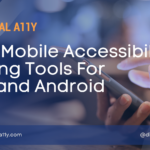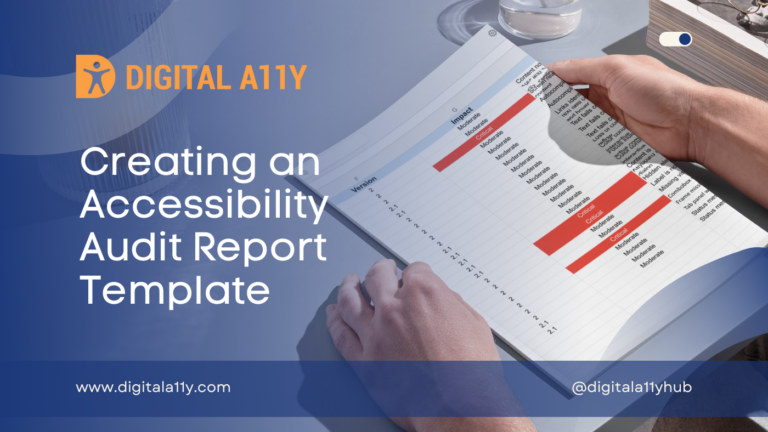Short Guide on Mobile Accessibility Testing For Android Apps

Accessibility Testing Checklist
Testing is an important part of making your application accessible to users with varying abilities. Following design and development guidelines for accessibility are important steps toward that goal, but testing for accessibility can uncover problems with user interaction that are not obvious during design and development.
This accessibility testing checklist guides you through the important aspects of accessibility testing, including overall goals, required testing steps, recommended testing and special considerations. This document also discusses how to enable accessibility features on Android devices for testing purposes.
Testing Goals
Your accessibility testing should have the following, high level goals:
- Set up and use the application without sighted assistance
- All task workflows in the application can be easily navigated using directional controls and provide clear and appropriate feedback
Testing Requirements
The following tests must be completed in order to ensure a minimum level of application accessibility.
- Directional controls: Verify that the application can be operated without the use of a touch screen. Attempt to use only directional controls to accomplish the primary tasks in the application. Use the keyboard and directional-pad (D-Pad) controls in the Android Emulator or use gesture navigation on devices with Android 4.1 (API Level 16) or higher.
Note: Keyboards and D-pads provide different navigation paths than accessibility gestures. While gestures allow users to focus on nearly any on-screen content, keyboard and D-pad navigation only allow focus on input fields and buttons. - TalkBack audio prompts: Verify that user interface controls that provide information (graphics or text) or allow user action have clear and accurate audio descriptions when TalkBack is enabled and controls are focused. Use directional controls to move focus between application layout elements.
- Explore by Touch prompts: Verify that user interface controls that provide information (graphics or text) or allow user action have appropriate audio descriptions when Explore by Touch is enabled. There should be no regions where contents or controls do not provide an audio description.
- Touchable control sizes: All controls where a user can select or take an action must be a minimum of 48 dp (approximately 9mm) in length and width, as recommended by Android Design.
- Gestures work with TalkBack enabled: Verify that app-specific gestures, such as zooming images, scrolling lists, swiping between pages or navigating carousel controls continue to work when TalkBack is enabled. If these gestures do not function, then an alternative interface for these actions must be provided.
- No audio-only feedback: Audio feedback must always have a secondary feedback mechanism to support users who are deaf or hard of hearing, for example: A sound alert for the arrival of a message should also be accompanied by a system Notification, haptic feedback (if available) or another visual alert.
Testing Recommendations
The following tests are recommended for ensuring the accessibility of your application. If you do not test these items, it may impact the overall accessibility and quality of your application.
- Repetitive audio prompting: Check that closely related controls (such as items with multiple components in a list) do not simply repeat the same audio prompt. For example, in a contacts list that contains a contact picture, written name and title, the prompts should not simply repeat “Bob Smith” for each item.
- Audio prompt overloading or underloading: Check that closely related controls provide an appropriate level of audio information that enables users to understand and act on a screen element. Too little or too much prompting can make it difficult to understand and use a control.
Special Cases and Considerations
The following list describes specific situations that should be tested to ensure an accessible app. Some, none or all of the cases described here may apply to your application. Be sure to review this list to find out if these special cases apply and take appropriate action.
- Review developer special cases and considerations: Review the list of special cases for accessibility development and test your application for the cases that apply.
- Prompts for controls that change function: Buttons or other controls that change function due to application context or workflow must provide audio prompts appropriate to their current function. For example, a button that changes function from play video to pause video should provide an audio prompt which is appropriate to its current state.
- Video playback and captioning: If the application provides video playback, verify that it supports captioning and subtitles to assist users who are deaf or hard of hearing. The video playback controls must clearly indicate if captioning is available for a video and provide a clear way of enabling captions.
Testing Accessibility Features
Testing of accessibility features such as TalkBack, Explore by Touch and accessibility Gestures requires setup of your testing device. This section describes how to enable these features for accessibility testing.
Testing audible feedback
Audible accessibility feedback features on Android devices provide audio prompts that speaks the screen content as you move around an application. By enabling these features on an Android device, you can test the experience of users with blindness or low-vision using your application.
Audible feedback for users on Android is typically provided by TalkBack accessibility service and the Explore by Touch system feature. The TalkBack accessibility service comes preinstalled on most Android devices and can also be downloaded for free from Google Play. The Explore by Touch system feature is available on devices running Android 4.0 and later.
Testing with TalkBack
The TalkBack accessibility service works by speaking the contents of user interface controls as the user moves focus onto controls. This service should be enabled as part of testing focus navigation and audible prompts.
To enable the TalkBack accessibility service:
- Launch the Settings application.
- Navigate to the Accessibility category and select it.
- Select Accessibility to enable it.
- Select TalkBack to enable it.
Note: While TalkBack is the most available Android accessibility service for users with disabilities, other accessibility services are available and may be installed by users.
Testing with Explore by Touch
The Explore by Touch system feature is available on devices running Android 4.0 and later, and works by enabling a special accessibility mode that allows users to drag a finger around the interface of an application and hear the contents of the screen spoken. This feature does not require screen elements to be focused using an directional controller, but listens for hover events over user interface controls.
To enable Explore by Touch on Android 4.0 and later:
- Launch the Settings application.
- Navigate to the Accessibility category and select it.
- Select the TalkBack to enable it.
Note: On Android 4.1 (API Level 16) and higher, the system provides a popup message to enable Explore by Touch. On older versions, you must follow the step below. - Return to the Accessibility category and select Explore by Touch to enable it.
Note: You must turn on TalkBack first, otherwise this option is not available.
Testing focus navigation
Focus navigation is the use of directional controls to navigate between the individual user interface elements of an application in order to operate it. Users with limited vision or limited manual dexterity often use this mode of navigation instead of touch navigation. As part of accessibility testing, you should verify that your application can be operated using only directional controls.
You can test navigation of your application using only focus controls, even if your test devices does not have a directional controller. The Android Emulator provides a simulated directional controller that you can use to test navigation. You can also use a software-based directional controller, such as the one provided by the Eyes-Free Keyboard to simulate use of a D-pad on a test device that does not have a physical D-pad.
Testing gesture navigation
Gesture navigation is an accessibility navigation mode that allows users to navigate Android devices and applications using specific gestures. This navigation mode is available on Android 4.1 (API Level 16) and higher.
Note: Accessibility gestures provide a different navigation path than keyboards and D-pads. While gestures allow users to focus on nearly any on-screen content, keyboard and D-pad navigation only allow focus on input fields and buttons.
To enable gesture navigation on Android 4.1 and later:
- Enable both TalkBack and the Explore by Touch feature as described in the Testing with Explore by Touch. When both of these features are enabled, accessibility gestures are automatically enabled.
- You can change gesture settings using Settings > Accessibility > TalkBack > Settings > Manage shortcut gestures.
Note: Accessibility services other than TalkBack may map accessibility gestures to different user actions. If gestures are not producing the expected actions during testing, try disabling other accessibility services before proceeding.
Related Articles
- Mobile Accessibility Testing Tools
- How to Perform Accessibility Testing on iOS Apps
- How to Perform Web Accessibility Testing
Reference: Android Accessibility Testing Checklist










